The second phase of the approved master plan for redeveloping the 33-acre public housing development atop Potrero Hill, a five-phase plan which aims to eventually rebuild over 600 units of distressed public housing and create an additional 155 affordable homes, along with approximately 800 market rate units spread across the site, with new community facilities, retail, open space, and neighborhood services, is underway.
Encompassing 4-acres of land bounded by 25th, 26th, Wisconsin and Connecticut Streets at the southern end of the Potrero Terrace and Annex Public Housing site, Phase 2 of the Potrero HOPE project will yield a new 157-unit affordable building and between 150 and 200 units of market rate housing, along with a new fiberoptic line which will provide free internet access to all affordable housing residents across the site. And with the infrastructure portion of the second phase slated to be completed next spring, construction is expected to begin next year.
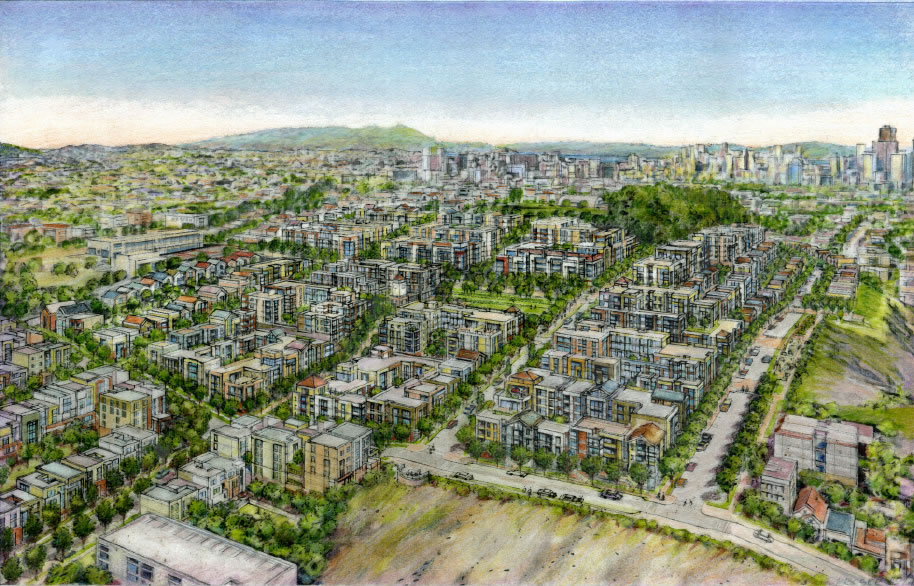
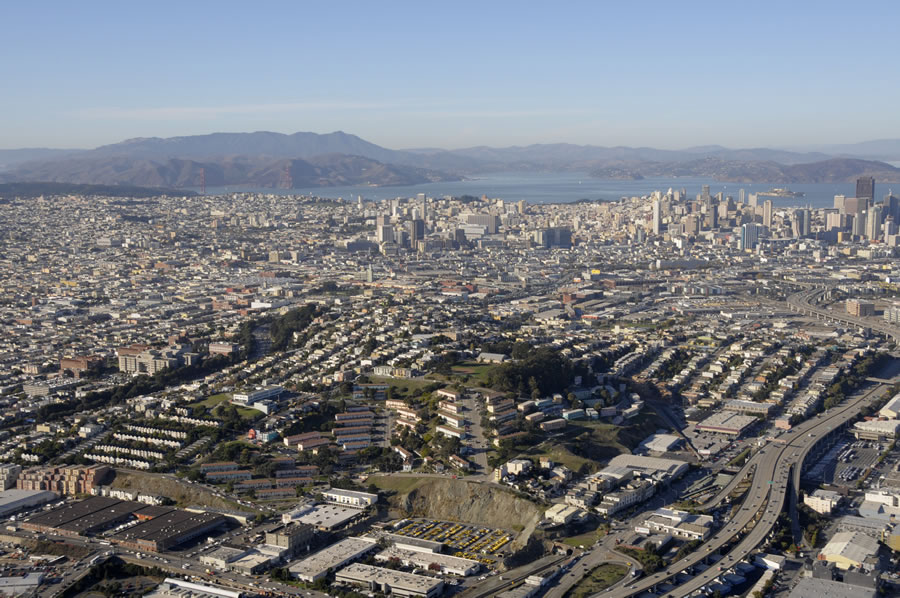
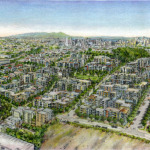
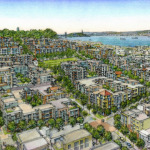
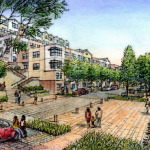
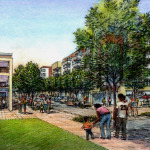
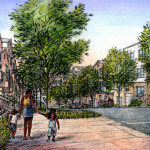
So the affordable housing residents get FREE internet access while the market rate & below market rate residents have to pay for the service?
And will these new market-rate renters have to pay a few hundred thousand extra in purchase costs or higher apartment rental rates to cover the builder’s costs for these newly rebuilt affordable and below market rate apartment tenants units?
Will the rents go up for these drastically upgraded affordable housing unit tenants or will they stay the same and the city also provide them a place to live while the units are re-built?
“…will these new market-rate renters have to pay a few hundred thousand extra in purchase costs or higher apartment rental rates to cover the builder’s costs for these newly rebuilt affordable and below market rate apartment tenants units?”
Nope! As always, market-rate units will rent/sell at the prevailing market rates, regardless of the builder’s underlying costs.
“Will the rents go up for these drastically upgraded affordable housing unit tenants or will they stay the same and the city also provide them a place to live while the units are re-built?”
While the rebuilt public housing units will be managed and owned by BRIDGE Housing or related entities, they will remain subsidized by the San Francisco Housing Authority. And the phasing of the redevelopment was structured to ensure that current residents could effectively remain in place while the units are rebuilt.
What’s the problem with people who make low wages getting free internet? I don’t see the problem. I don’t know…Maybe it’s because I work with working class people, who have been are overwhelmingly people of color, and it’s sad to see how many of them don’t have internet because they can’t afford it.
Yea. At the very least if we can’t afford to give poor people education, the best scenario is giving them access to information. I think free internet for public housing is a wonderful idea on a per dollar basis.
Prior to 2004 I would have agreed with “C”‘s sentiment. Lately, however, I’ve witnessed the best minds of the generation following mine devote themselves to turning the Internet into a worse version of television.
What with all of the facebooking, Snapchatting, Tii-Toking, Instagraming, YouTubeing, Twittering and Twitching, I think there’s probably on a kilobyte for kilobyte basis, more addictive distractions on the Internet than useful educational content (yes, I know there’s lots of educational information on Youtube and the other sites).
They’d be better off with a public library card and traditional hard copy books.
So much of day to day life requires the internet. Our government is moving internet-first. Want a vaccine appointment? Or to enroll your kid in school? Or get an appointment at the DMV? So many more things. I understand your sentiment, but please consider that saying that we shouldn’t give them internet access to protect their mind is paternalistic Neo-colonialist thinking.
What’s the deal with that big cliffside and parking lot just to the south? Anyone know why that area remains undeveloped? Seems like a prime site.
While Yellow Cab ended up selling the parcel in 2017, it remains a vehicle depot, but now for Prologis which acquired the site (which is zoned for development of PDR uses up to 65 feet in height).
I would guess it’s a former quarry. A lot of different part of the hill were excavated a smoothed out and the material used to fill in areas to the east down by the water.
Good guess. There used to be a quarry around the side of the hill on Sierra. A scene from the film “Dirty Harry” was shot there.
I really like the imaginary streetscape of the third drawing on the bottom slideshow. Unfortunately the payoff of this project is in phase 5, where the Connecticut St. stairs, 24th, and 24½th streets will be built. Considering we are in the 12th year of the project, I am not sure when to expect phase 5.
While it has been in the works for over a decade, keep in mind that the master plan for the Potrero Hill project wasn’t actually approved until 2017. And the first infrastructure phase and affordable building was completed in mid-2019.
Looking forward to the changes on this part of the hill. Question: Is there a reason for not mixing up the look and feel of the architecture of such a large project? I get economies of scale to some degree, but it seems like it would benefit the area long term if there was a mix of building styles. After 25 years, and fashion changes, would such a homogenous neighborhood trend down? Or is it saved by its views/location? Are there examples of large scale, California developments that have stayed desirable 20-30 years after they were built?
I think it’s really difficult to say. IMO, a lot of the stuff that was built in the 80s and 90s didn’t put nearly as much thought into streetscape, landscape architecture more broadly, amenities, etc. as these newer developments do. I feel that these newer projects will age better and have more staying power in their appeal, but only time will tell.
Hmmm. Just seems like it would make for a more visually interesting area if more architects could contribute. A great opportunity to be a stellar contemporary neighborhood.
Boy, the comments on the 2014 post are quite impressively racist.
I hear you. So are the comments from today’s Chronicle article about Phase 2 of Potrero HOPE.
Please explain where they are racist. I went to the 2014 article comments, and didn’t see any race mentioned good or bad.
“Are these people truly poor and/or disabled? They don’t look so at the Safeway nearby, buying groceries with SNAP cards, booze and cigarettes with cash.”
“If those interior spaces are what they look like, they’ll turn into drug bazaars.”
Oldest dog whistles in the book.
One comment in about 40? I think that says more about you than the comment thread in question.
And the comment is obviously based on person observations at the Safeway at 16’th and Potrero Av. I’ve seen the same. Although as its the nearest Safeway to three projects hardly surprising. Army St, Potrero Ave and Potrero Hill. The comment was truer back before the big rebuild of almost all projects in the City in the mid 1990’s. When the replacement units were very deliberately only 90% of the original density. All the problem people were not rehoused and ended up in the East Bay. So a much better life for the other 90% who lived in public housing in the City and everyone else in the neighborhood.
The Potrero Hill projects were the only ones not rebuilt in the 1990’s. Never heard a good reason why. So its great to see those terrible buildings replaced. The new ones already build look great. And also by the great improvement in the area in the last few years. I suspect all the problem people were moved out first. If you took the 10 bus regularly all the way to SF Gen you would get to hear the stories of just how badly maintained the buildings were and how the city refused to deal with the people in the few problem units who caused all the problems. So very happy to see the people who live there finally get housed in buildings that were not built as short term temporary housing almost 80 years ago.
But it does raise a more fundamental question. Why is 50% of all public housing in SF given over to one group that make up less than 5% of the population. Especially as it seems the classic welfare trap scenario. Over the last 40 year more than 2/3’rd of the group not living in public housing moved out of the City. But those in public housing did not. So that the main reason why the poverty rate is three times other groups. The poor people cannot afford to move somewhere nicer.
But in the meantime very happy that the people on the South Slope finally have somewhere that is not horrible and soul destroying to live in. So hopefully in a few years the area will be as pleasant as around the Page St projects or even the VG. Those who remember the 1980’s will know how big the change was after the rebuilds.
That’s not accurate regarding Potrero being the only ones not rebuilt in the 90s. Westside Courts, Alemany projects, Sunnydale, there are more I’m not thinking of a the moment …
Two comments by different usernames, and yes it does say something about me – I call out racism when I see it. What do you do?
And a completely unrelated question – you ask “why is 50% of all public housing in SF given over to one group that make up less than 5% of the population.” what group are you referring to?
You didn’t say two or some though you said “the comments.” I’m with you, by the way. But you’re talking about SFGate comments and it’s a given that there are gonna be creeps chiming in from all over the place to own some libs. A lone two outta one of those cesspool sample sets is actually negligible.
Hmmm. Just seems like it would make for a more visually interesting area if more architects could contribute. A great opportunity to be a stellar contemporary neighborhood.
Each phase of the development is being designed by a different architecture firm, selected through a public RFP process. The Master Plan is conceptual and does not show the variation of architecture.
This is the master plan folks…not designs for specific buildings. Undoubtedly many architects will contribute over the decades this takes to develop; building programs and preferences will evolve; construction methods and materials will evolve; building codes will change. Take a look at Hunters View or the Shipyard to see how there is a master plan that sets the street pattern, the open space pattern, and building locations, but each project is a different architect.
I wish they would keep just one of the barracks buildings that are there now. One of them, sitting angular on a corner, restored and used as a community space with a nice garden around it would be a very cool anchor to the history of the space.